
When Australian troops first deployed to Afghanistan in late 2002, the Australian Defence Force (ADF) had no unmanned aircraft and not much experience beyond some trials, which did show the vast potential for this technology.
Sixteen years on, the ADF is becoming a UAS (unmanned aerial systems) force with all three services set to possess its own advanced UAS capability to meet its particular operational requirements.
As the ADF becomes increasingly networked, the aspiration is for UAV product to be distributed across the Defence Force to precisely where it’s needed.
That could be a synthetic aperture radar (SAR) image of a suspect illegal fishing vessel in the Southern Ocean taken from a Triton 50,000 feet overhead, video of a terrorist gathering in the southern Philippines taken from a Reaper – and followed up with a Hellfire missile – or an image of an insurgent hideout in southern Afghanistan, obtained surreptitiously by an Army Black Hornet, a sparrow-sized UAV.
In time of bushfire, cyclone or flood, ADF UAVs such as Triton or Reaper can overfly an area before and then again afterward, producing very detailed current imagery of the extent of damage to allow relief to be most appropriately directed.
ADF UAVs with their very advanced sensors could join search and rescue missions or a hunt for lost hikers or be deployed as the eyes of a taskforce engaged in a peace restoration mission.
The ADF appetite for UAVs has emerged and grown steadily since the late 1990s when the Army conducted trials with the Australian Codarra, developed by Codarra Advanced Systems, of Queanbeyan, NSW.
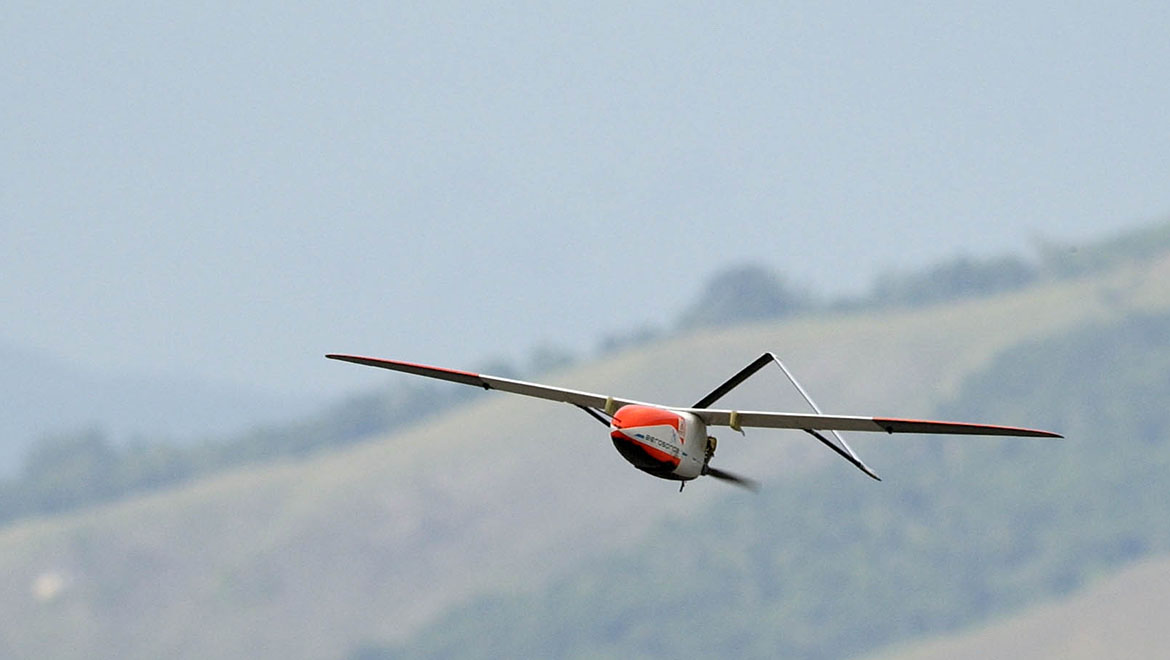
This early UAV was rudimentary, essentially a radio-controlled model aircraft with a camera, but it gave the Army an introduction to this capability.
In August 2003, Australian troops tried out four Australian-made Aerosonde UAVs during the peace restoration mission in the Solomon Islands.
This was the first ever Australian operational deployment of UAVs and proved extremely useful in learning just how to use these new devices and just what they could do.
As well as producing useful imagery of some of the more remote areas and less accessible villages of the Solomons, these had a less tangible but nonetheless real effect, as mission commander Lieutenant Colonel John Frewen wrote in Defence magazine at the time.
“Our tactical UAVs were also a potent psychological tool that clearly played on people’s minds. We openly displayed our abilities and the imagination of the locals took over from there,” he said.
The war on terror showed how UAVs could be far more than just useful novelties. As US forces bore the brunt of fighting in Afghanistan and Iraq, they turned to UAVs for long‑endurance intelligence, surveillance and reconnaissance (ISR) missions and increasingly for strike.
UAVs in many guises have existed longer than manned flight. Wikipedia dates the first use of a type of UAV to 1849 when the Austrians launched balloons full of explosives at the city of Venice.
Pilotless aircraft, tried out after World War 1, followed the development of radio. In the absence of useful sensors, this technology was directed to producing target drones, widely used for gunnery practice during World War 2. Australia’s own Jindivik first flew in October 1950 and remained in service right through to 1998.
This technology was also directed to missile guidance. During WW2, the US Army Air Force used war-weary B-17 and Liberator aircraft, packed with explosives, fitted with early TV guidance and radio-controlled from another aircraft to attack German V-1 launch sites and U-boat pens.
None of the 14 missions succeeded and what was code-named Operation Aphrodite is chiefly remembered for the death of one pilot, Lieutenant Joseph Kennedy, older brother of the future president, killed when his aircraft exploded prematurely over southern England.
The Cold War and the need to see what the other side was doing gave impetus to development of reconnaissance drones. The US had its very effective U-2 manned spy plane but a flight over the USSR in 1960 caused no end of trouble when the aircraft was shot down and its CIA pilot captured.
The US used unmanned surveillance aircraft extensively for missions over North Vietnam throughout the Vietnam War and these proved most useful and also expendable.
Israel enthusiastically adopted UAVs for ISR and the Israeli Air Force showed just what was possible in a single day in June 1982.
Using Tadiran Mastif and IAI (now Israel Aerospace Industries) Scout UAVs for real time battlefield surveillance, Israeli aircraft obliterated Syrian air defences in the Bekaa Valley and then shot down as many as 86 Syrian aircraft for no losses.
This one-sided victory had wide-ranging consequences, including demonstrating the force multiplier effect of imaginatively deployed UAVs.
The General Atomics Predator and its successor the Reaper, perhaps the best known of the current generation battlefield UAVs, stemmed from a series of CIA and US military projects launched in the early 1980s.
The first Predator flew in 1994 and its first deployment was to the Balkans in 1995. Loss rates of these early aircraft were high, mostly as a result of operational accidents rather than enemy action.
In mid-2000 the USAF thought maybe it could arm these aircraft, and trials with the Hellfire missile showed it was indeed possible – just in time for operations in Afghanistan.
Afghanistan and Iraq were very much UAV wars, with a near insatiable demand for their ISR product.
After Aerosonde, the Australian Army acquired the Israeli Elbit Skylark – a tactical UAV with a two-metre wingspan – in a rapid acquisition in 2006 specifically to support the taskforce in southern Iraq.
Skylark also operated in Afghanistan and East Timor, where in May 2007 one drew attention to the capability by crashing into a house in Dili. There were no injuries and defence personnel fixed the modest damage to better than it was pre-crash. The mishap was attributed to an unspecified technical fault.
Skylark was speedily followed by the Scan Eagle from Insitu Pacific, a Boeing subsidiary. This was a larger three-metre wingspan petrol engine‑powered UAV with endurance around 14 hours. Scan Eagle flew 45,000 hours in Iraq and Afghanistan.

In one incident in southern Iraq, an Australian Scan Eagle spotted a group of Iraqi insurgents setting up a rocket rail and then firing a rocket into Basra. They speedily dismantled the rail, loaded it into a vehicle, scooted up the road then stopped to set up again. A JDAM, apparently from a Dutch F-16, ended their day.
Scan Eagle remains in the Australian Defence Force inventory, although now with the Navy.
Australian Special Operations Command also acquired the widely used AeroVironment RQ-11 Raven for use in Afghanistan. This is a small 1.3 metre wingspan hand-launched UAS for tactical use.
With its taste for UAS thoroughly stirred, the Army acquired the US AAI Corporation Shadow in 2011. This is a tactical UAV with a 4.3 metre wingspan which flew 10,000 hours in Afghanistan. It remains in the Army inventory.
The US military experimented with weaponising the Shadow after one in Afghanistan spotted a large number of high value targets and could do nothing but look on as they escaped. Trials showed this was possible but even a modest munition substantially degraded performance of an aircraft whose main role should be persistent surveillance.
Operations in Afghanistan also showed the need for a UAV with capability greater than that provided by the smaller tactical UAVs. What was needed was what’s termed a medium-altitude long-endurance (MALE) UAS.
Just such a capability became available with Australia taking over the lease of Canadian IAI Heron aircraft as Canada drew down its military presence in Afghanistan.
Between January 2010 and November 2014, the RAAF flew Herons more than 27,000 hours out of their operating base at Kandahar, providing overwatch of ground operations by Australian and coalition forces.
“It got the Air Force into the game and we much needed that. There was no real selection. The Canadians had a lease which was coming up and we could take it over and gain a capability,” said one former RAAF officer.
“It was in great demand because there was such a scarcity of ISR.”
Heron flew its last mission from Kandahar in November 2014 and officially retired from the ADF inventory in June last year.

That has left the ADF without a MALE UAV until new capability is delivered under project AIR 7003, likely early next decade.
This will be a very controversial acquisition as Defence has specified that this new UAV be armed. As well as providing persistent ISR for ground forces, it would also be able to provide close air support.
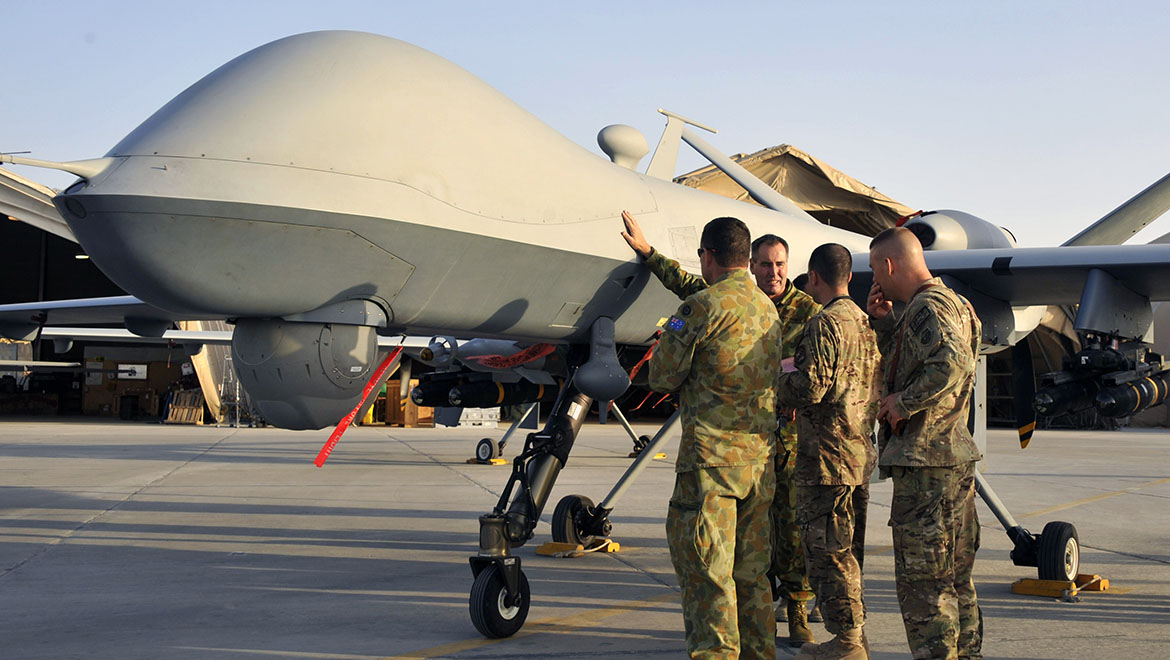
There appear to be two contenders – IAI with the Heron TP, a larger version of the familiar Heron, and General Atomics Aeronautical Systems which is offering a choice of two – the MQ-9 Block 5 Reaper (also known as Predator B) as now used by the US Air Force, or the MQ-9B SkyGuardian, the latest variant set to be provided to the UK. SkyGuardian is larger, has a longer range and greater payload, and is GA’s preferred offering.
Although the RAAF cut its teeth on the original piston-powered Heron, General Atomics with Reaper appear to be the frontrunner at this time. RAAF personnel have even trained on Reaper in the US since 2015, even flying as pilots and missions systems operators on actual missions as embeds with US units.
Defence has said little about how it will proceed with this procurement. There’s been speculation that it could proceed straight to a single source acquisition.
Whatever is acquired, this will be a contentious decision, with the inevitable accusation that the ADF is acquiring ‘killer drones’ just like those the US has used in its campaign directed at militants in northern Pakistan and elsewhere.
The ADF has even proposed that there be a PR campaign designed to show that these aircraft will have many other uses, including disaster relief and search and rescue, that they aren’t autonomous and that there are clear procedures and policies governing lethal use.
From Afghanistan, the Army also learned that while UAV big picture ISR is useful, what’s also useful for soldiers on the ground is the ability to look over a hill or even over the wall of a mud brick compound to see if insurgents are inside or if it’s been wired up with improvised explosive devices.
After three years of trials, the Army is rolling out a pair of systems designed to give the soldiers just this ability, with the government announcing it would spend $101 million on a small UAS for the Army.
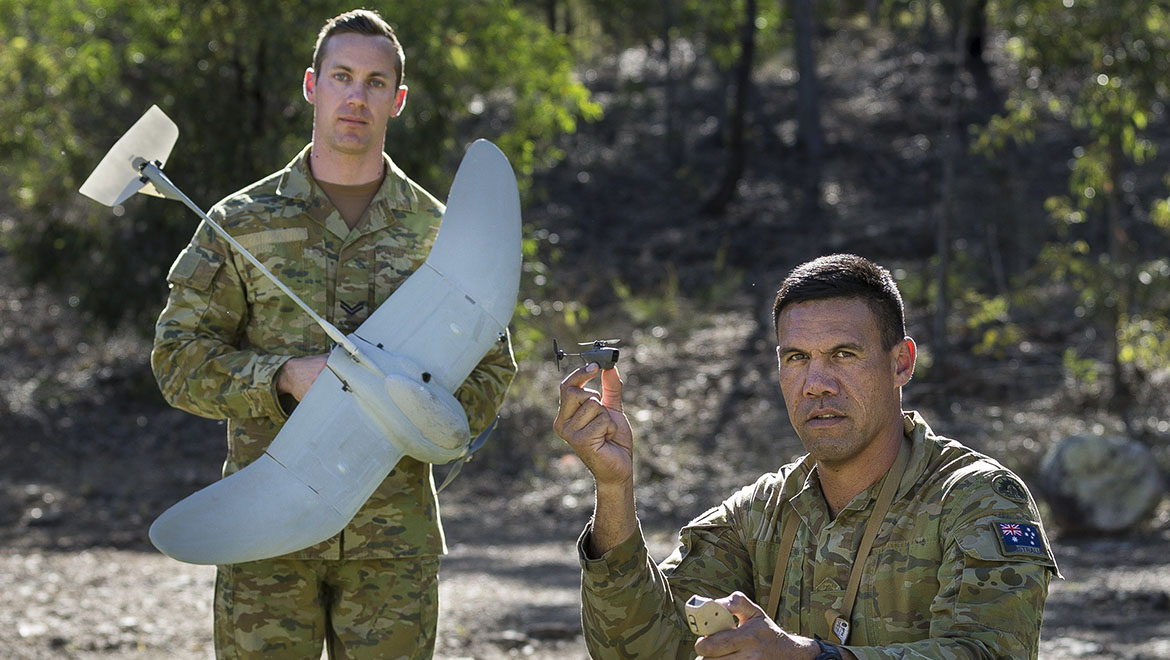
That’s the AeroVironment Wasp AE, a hand-launched fixed-wing UAS with wing span just over a metre, endurance of 50 minutes, range of about five kilometres and operating altitude of about 150 metres.
Most importantly, Wasp has both day and night cameras on board. The datalink is line of sight in the encrypted military band, about 2.2Ghz, with imagery transmitted to a ruggedised tablet.
“All of that imagery goes to a laptop with a moving map with all the data displayed and the commander gets all of that. If it goes to a laptop that gives us extra capabilities. We can tie it into a network, put it up onto a big screen – do all sorts of things,” Lieutenant Colonel Keirin Joyce, manager of the Army’s unmanned aerial systems (UAS) program told Australian Aviation.
There’s also Black Hornet, developed by Prox Dynamics of Norway and in service with the Norwegian, British and German armed forces.
Black Hornet has been used by the British Army in southern Afghanistan where it proved particularly useful for looking into compounds for lurking insurgents.
Termed a nano-UAS, this is a truly tiny rotary wing UAS which comes in two variants equipped with different sensors – grey airframe for daytime and black for night. It will be issued down to platoon level.
“We have had these in trials now for three years. We are rolling them out across the army over the next two years. So every combat unit in the Army will have access to Black Hornet,” LTCOL Joyce says.
“It is the size and weight of a sparrow. This has the capability of operating up to two kilometres away for 20 minutes. Through its built-in cameras you basically put an eye in the sky…to look at your next step to help in planning – over the hill, around the corner or inside windows if you are going into urban terrain.”
The Navy is a relative latecomer to UAS but will soon be a major operator.
Flying UAVs from ships presents different challenges to overland operations and the Navy has been on a significant journey to determine just what maritime UAS (MUAS) can do, how they can be operated from aboard a ship and what skills and training their operators need.
The plan is to first acquire MUAS for operation from new Offshore Patrol Vessels and then new Future Frigates and other warships.
The US Navy took an early interest in UAS, signing a deal with Insitu, now a subsidiary of Boeing, in 2005 and now has extensive experience of operating Scan Eagle UAVs from its ships.
The Australian Navy started looking hard at MUAS in 2012 with the formation of the Navy Unmanned Aerial Systems Unit (NUASU), soon to be commissioned as a Navy squadron.
NUASU officer in charge Lieutenant Commander Ben Crowther said the aim was to establish a basic understanding of UAS operations, develop orders, instructions and procedures on their safe and effective operation.
“It was about making Navy an informed customer,” he said.
That started with learning the basics on small quadcopters, which actually may have an enduring use for conducting ship hull and mast inspections and for discrete observation of intercepted vessels.
In early 2013 Navy took over the Army’s Scan Eagle contract with Insitu Pacific and in 2015 purchased a pair of Scan Eagle systems outright, each with ground stations and four aircraft, making a total of eight aircraft, at an all-up cost of $15 million.
It conducted a trial deployment of six Scan Eagles to Christmas Island in 2016 and last year conducted their first real operation, with four Scan Eagles deployed on HMAS Newcastle, flying more than 200 hours during a six-month deployment to the Middle East.
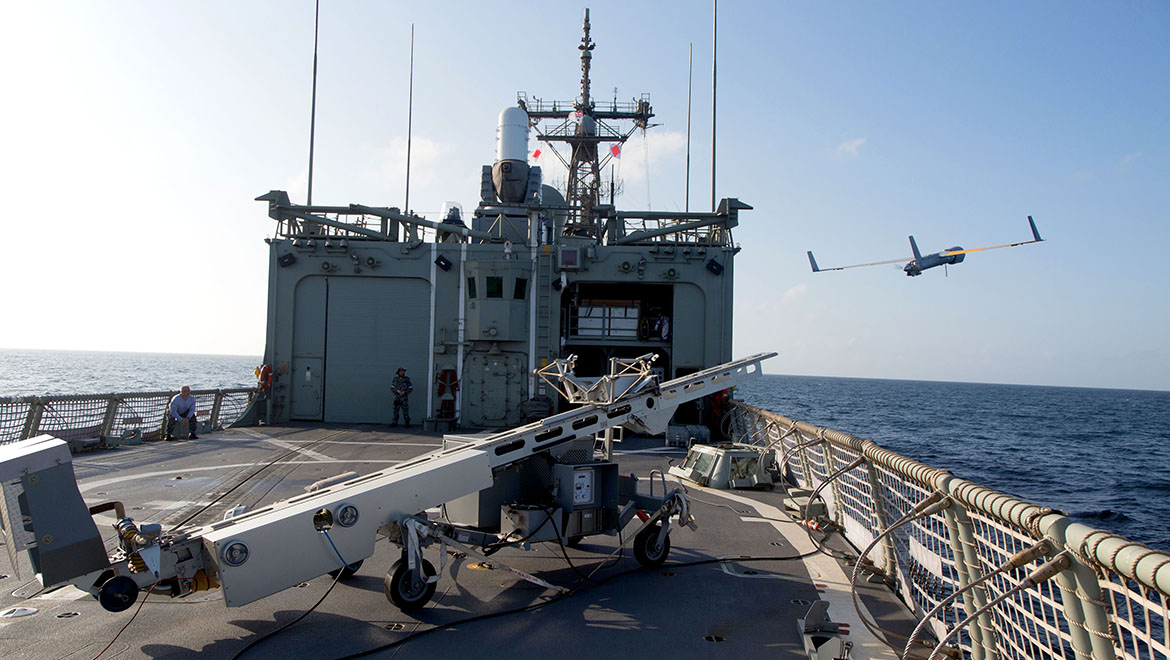
During this mission, the Navy tried out what’s termed manned-unmanned teaming, with Scan Eagle operating in conjunction with the embarked Seahawk Romeo helicopter.
This is the way of the future and not just for Navy UAS, with the UAV performing the tedious repetitive surveillance then handing off where needed to the manned platform – think Reaper and Tiger Armed Reconnaissance Helicopter or Triton high altitude long endurance maritime surveillance UAV and P-8A Poseidon.
Since the Navy has vast experience flying helicopters from warships, it’s also looked at rotary-wing UAS and after trials, decided to buy an Austrian Schiebel S-100 system, comprising two aircraft, two ground stations and two years of support to further explore this capability.
Fixed-wing and rotary-wing UAS each have advantages and disadvantages.
Scan Eagle can stay aloft in excess of 12-hours, is efficient and covert. But it has a small payload of a single sensor package, albeit very good ones. Sensor capability across all UAS is improving all the time.
S-100 is larger than Scan Eagle – it weighs almost 200kg – and much more complex and has around half the endurance. But it can carry a much larger payload of up to 50kg, which could include multiple sensors. It even has sufficient power output to run a radar.
For a small UAV, Scan Eagle has a big deck footprint, requiring a pneumatic catapult to launch and skyhook, which catches the wing, to land. That amounts to around 2,500kg of equipment.
S-100 only needs a clear deck area to take off and land.
Both systems have a similar requirement in another area, needing six-seven bunks for the embarked crew, not always easily obtained on a vessel heading off on a long deployment.
A permanent MTUAS capability is now being acquired under the SEA 129 project, likely to be the S-100 or the larger Saab/UMS V-200 Skeldar.
When it comes to UAS, there’s nothing to match the Northrop Grumman Triton, an airliner-sized UAV with a very special mission – to patrol at high altitude out over Australia’s vast surrounding oceans, their sensors scanning for all sea traffic below.
Australia has long required a broad area maritime surveillance (BAMS) capability and not just to look for asylum seekers arriving on small boats. There’s illegal fishers operating in Australia’s eight million square kilometre exclusive economic zone, drug smugglers and potentially, terrorists.
Australia is also responsible for one of the largest search and rescue areas in the world, some 53 million square kilometres in the Indian, Pacific and Southern Oceans. As well, it’s useful to have an understanding of the patterns of sea traffic in our part of the world.
Australia already has part of a BAMS capability through the RAAF’s fleet of AP-3C Orion aircraft, now being replaced by the Boeing P-8A Poseidon, and the Jindalee over-the-horizon radar system which can detect ships and aircraft far out to the north and west.
What makes Triton special is an ability to fly very high for a very long time – over 55,000ft for 24 hours at a time. Flying from RAAF Edinburgh in South Australia, a single Triton could range far out into the Indian Ocean and up almost to the Indonesian archipelago, spotting every passing vessel, even small boats, using its advanced sensors.
As UAVs go, Triton is big. Its 39.9 metre wingspan is four metres larger than the Boeing 737’s.
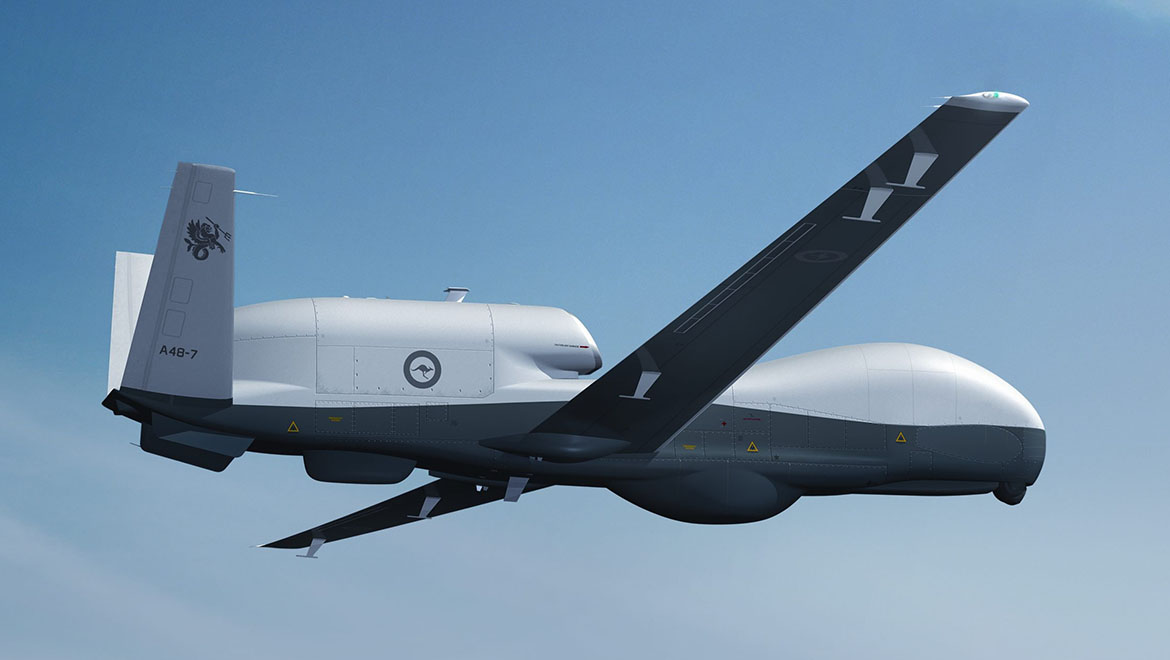
It’s been a long time coming. In 1998 Global Hawk, Triton’s predecessor, made its first flight and in April 2001 amply demonstrated its ability to cover intercontinental distances when a development airframe flew non-stop from Edwards USAF base to RAAF Edinburgh, covering 13,219km in 22 hours.
That was the first pilotless aircraft to cross the Pacific and a world record for absolute distance flown by a UAV.
Despite the potential of this technology and the obvious need, Australia has run hot and cold on making a firm commitment. The coalition government of John Howard was dead keen and in July 2006 gave first pass approval for participation in cooperative development of a maritime Global Hawk with the US Navy.
But in 2009 Labor defence minister Joel Fitzgibbon announced Australian involvement would be deferred, citing pressures on the RAAF as it transitioned from Orion to Poseidon. The US proceeded and the first Global Hawk configured for maritime surveillance, the MQ-4C Triton, flew in May 2013.
Then in 2014, new PM Tony Abbott announced we would get Triton. The 2016 Defence White Paper says there will be seven, operating in conjunction with 15 Poseidons.
It now appears the government will make the long-awaited gate two decision this year with the first aircraft entering service in 2023.
Northrop Grumman says it’s a good time for Australia to be making this commitment as it moves from low rate initial production to full production for the US Navy.
This would be a Foreign Military Sale (FMS) deal through the US Navy. Media reports have cited a unit price around $200 million each.
Just how well Triton works will soon be seen with the US Navy deploying two aircraft to Guam where they’ll fly in support of the US Seventh Fleet, conducting intelligence, surveillance and reconnaissance missions over some of the most sensitive territory on the planet.
This feature article first appeared in the March 2018 issue of Australian Aviation.














